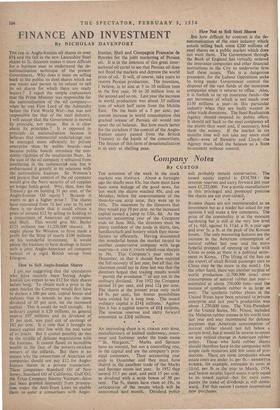RUBBER shares are not recommended as an investment but as
a reader has asked for my opinion I will make a few comments. The price of the commodity is at the moment hardening but is still at the very low level of Is. 41d. against is. 110. a lb. a year ago and over 5s. a lb. at the peak of the Korean boom. The only reassuring features are the increase in the American consumption of natural rubber last year and the more hopeful prospect of opening up trade with China as soon as there is a political settle- ment in Korea. (The lifting of the ban on the export of small British passenger cars to China may be the straw in the wind.) On the other hand, there was another surplus of world production (1,700,000 tons) over consumption of natural rubber last year— estimated at about 250,000 tons—and the menace of synthetic rubber iS as large as ever. The synthetic rubber plants in the United States have been returned to private enterprise and last year's production was about 1,250,000 tons. The Vide-President of the United States, Mr. Nixon, included the Malayan rubber estates in his world tour last year and may recommend for defence purposes that American consumption of natural rubber should not fall below a certain level, but it would be unwise to count on any radical change in American rubber policy. Those who hold rubber shares should therefore keep to the companies with ample cash resources and low costs of pro- duction. There are some companies whose estate costs are under Is. per lb.—HENRIETTA RUBBER, for example, estimates its costs at 10.6d. per lb in the year to March, 1954, and boasts surplus liquid assets nearly equal to its issued capital—but for most com- panies the trend of dividends is still down- ward. For that reason I cannot recommend new purchases.


































 Previous page
Previous page